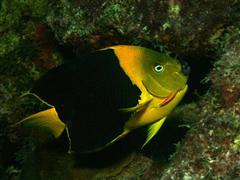Angelfish - Rock Beauty
Scientific Name: Holacanthus tricolor
Mon, 28th April, 2025 - 1:26 pm GMT
Sponsor Ads:

Alternative Name
Scientific Name: Holacanthus tricolorBasic Info
By maturity, many captive Rock Beauty Angels reach about eight inches (20 centimeters) in length, though it said that they can grow up to 2 feet in the wild. They are yellow and black in color. Mature Rock Beauty Angels are mostly yellow. The forebody and the tail are both yellow or yellowish-orange in color. The midrange of the body and the rear of the body are both black. Often, the black area is simply a large color fill over the middle and rear of the body, outlined with yellow above and below. Some have blue lips or faces. As juveniles, Rock Beauty Angels are entirely yellow, with a single black spot marking the middle of the fish.
Health
A single Rock Beauty Angel needs an aquarium of at least 80 gallons in volume. Temperatures should remain between 72 and 78 degrees Fahrenheit (23 to 26 degrees Celsius). The pH should remain at 8.3 or 8.4, with a specific gravity between 1.020 and 1.025. If a fish is kept alone in an enclosure, 1.020 to 1.023 would be acceptable, though in an enclosure containing invertebrates, salinity levels should remain between 1.023 and 1.025 in order to keep those animals healthy. Rock Beauty Angels in an aquarium containing invertebrates may nip at hard or soft corals and tridacnid clams. They do not tolerate members of their species and may not get along well with similar fish. The Rock Beauty Angel's diet should be as varied as possible. Often, shrimp, algae, sponges, and spirulina are offered. Rock Beauty Angels have a reputation for being susceptible to skin diseases.Habitat
Saltwater fish - They are commonly seen in the Caribbean, where they are often collected for the pet tradeBehavior
The delicate Rock Beauty Angel is a beautiful fish. It can be quite rewarding to keep one of these exquisite Angels. In the wild, Rock Beauty Angels frequent coral reefs, rubble reefs, or shallow rock jetty areas. Sponges, sea squirts, algae, and polyps are all common foods for Rock Beauty Angels. In a home aquarium, these beautiful fish should be fed a wide variety of foods to simulate this natural diet. They usually do not get along well with other similar fish or fish of the same species, and establish well-defended territories in the wild. Rock Beauty Angels may pick at tridacnid clams or hard and soft corals and are not considered reef safe.Origin
CaribbeanHistory
Rock Beauty Angels are native to the Atlantic regions of South America and southern North America. . Along the coasts of the Americas, they may not be as brilliantly colored as those found in island regions.Common Foods
N/ASponsor Ads:
The sole reliable test of a first-rate intelligence is to hold two opposite ideas in the mind whilst still retaining the ability to tie one's own shoe laces. -- Unknown
Angelfish - Rock Beauty
Coded by: BGID® | ALL RIGHTS RESERVED Copyright © 2000-2025
Disclaimer | Privacy | Report Errors / Contact | Credits
















